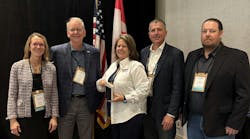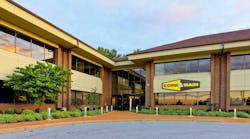About the author: Elizabeth Lisican is associate editor for Storm Water Solutions. Lisican can be reached at 847.954.7958 or by e-mail at [email protected].
As evidenced by the U.S. Environmental Protection Agency’s publishing of its final rule on effluent limitation guidelines in late 2009, erosion and sedimentation control is gaining revolutionary new ground. The recent launch of the first set of model codes and standards for “green” building in the U.S. represents another milestone many believe will accelerate the construction of high-performance green buildings nationwide. Thus, the relevance of U.S. Green Building Council (USGBC) Leadership in Energy and Environmental Design (LEED) and low-impact development extends far beyond sales buzzwords within the massive green marketing trend.
Further, the USGBC recently announced its push for more college and university campuses to become sustainable with its Green Campus Campaign. Perhaps one example indicative of this was the University of Texas (UT) Southwestern Medical Center Campus’ pursuit of Silver LEED certification.
To help the medical center achieve its LEED goals, in the summer of 2009 Hanson Pipe & Precast provided in-line box culverts for a new rainwater detention system covering 2,800 sq ft of surface area. Hanson was able to meet the Dallas medical center’s requirements for more than 100,000 gal of storage for irrigation and detention storage: The box culverts are capable of 100,500 gal of irrigation storage and 40,200 gal of detention storage.
Space Issues
Engineers at Halff and Associates in Dallas designed the underground detention system, which collects rainwater runoff and uses the captured water for the sprinkler systems at the medical center. Hanson Pipe & Precast’s Grand Prairie, Texas, facility provided a series of in-line box culverts in an effort to build an efficient system designed to accommodate the limited space and flotation risks at the site, and also to ease installation for contractor Wright Construction.
The box culverts were set close to an existing building, so space was limited on site. “They didn’t have any room to go wider, so we went taller,” said Matt Daniel, central Texas area sales manager for Hanson Pipe & Precast. “We provided a four-barrel—which meant four different lines—of box culverts. We delivered one line on one day, and the contractor set it the next. So, the entire structure was delivered and installed in less than a two-week period.”
Each box culvert structure provided measures 10 ft across and 11 ft tall. “Originally we had designed a 10-by-10 box culvert, but the requirements of the water required us to provide a special design, which Hanson did in house to increase the storage capacity because of the limited space at the job site.”
Simple Innovation
Richard Manning, president of Hanson Building Products, said he views sustainability as a practice of reverting to ideas that worked in the past in order to spur innovation.
“If we just do the simple things—looking at the pyramids, which are 4,500 years old, or looking at the Romans—the technology in underwater piping and so on is 2,000 years old,” he said. “It’s all about looking at the past and learning from it, and then restoring a balance so you’re actually using sustainable building materials in order to create the future now... Concrete is a sustainable building medium. We saw UT Southwestern as an opportunity to get our footprint out there to an educational establishment."
But in turn, Daniel said, the products helped Wright Construction keep its carbon footprint in check.
“The beauty of what we did here was that our in-line box culverts were a complete system in that we really reduced the amount of in-field construction that Wright Construction had to do with the project,” he said.
This use of box culverts also reduces the need for potable water to be used outdoors. In addition, the products are made partially with recycled materials. According to the company, manufacturing reinforced concrete pipe (RCP) creates 87% fewer carbon emissions than alternative pipe materials such as high-density polyethylene.
Hanson said its RCP is made of primarily local, natural, nontoxic elements from sand, gravel and crushed stone—which means it is not flammable, will not react with other materials and will not release chemicals into its surroundings. Thus, even though building products themselves cannot be LEED certified, these products contribute to LEED credits in the categories of Regional Availability and Recycled Content.
Hanson also was able to cast in at its local plant all of the different access points that Wright Construction requested—in case workers needed to access the detention pond and the weir system, which Hanson cast into one of the boxes itself. It held the water in check until it reached a certain level.
“That weir wall would allow water to pour over it once it reached its maximum capacity,” Daniel said. “So we really allowed the contractor a very cost-effective, complete structure.”
Feedback to Follow
Because this project exceeded requirements of the Silver LEED certification level for which it was submitted, the exact level attained is not yet known.
“Wright Construction was very pleased with what we provided,” Daniel said. “The boxes look a little different because it is a detention pond. But the way that they are installed and the overall performance of the box culverts is something they are very used to in the installation process.”
The system will be put to the test when the sprinklers are used this spring, Manning said. “This issue of harvesting water is something that we really need to push across the U.S. We did get this right once, and then we went wrong. And let’s try to [focus] on producing and using building products that are made of concrete or clay—natural materials that are inherently sustainable. What I try to tell people is that this is not a nice-to-have; this is a must-have, and it will happen.”
Sidebar
Big Impact on Campus
Low-impact development is making a mark in many respects. The USGBC is striving to “green” hospital and college campuses nationwide with programs like LEED for Healthcare and the Green Campus Campaign. Those institutions are encouraged to pursue LEED certification because the rewards can be monumental.
The following USGBC-cited benefits are just some of many seen in the field:
• Better air and water quality, with minimal impact to the Earth—which typically is brutally affected by today’s $41-billion health care construction industry;
• Healthier conditions for hospital patients, which can lead to shorter hospital stays and quicker healing;
• Engaged donors, alumni and prospective students;
• Design innovation;
• An added degree of credibility to sustainability claims; and,
• Leadership opportunities for youth through USGBC-partnered student groups.
Download: Here

